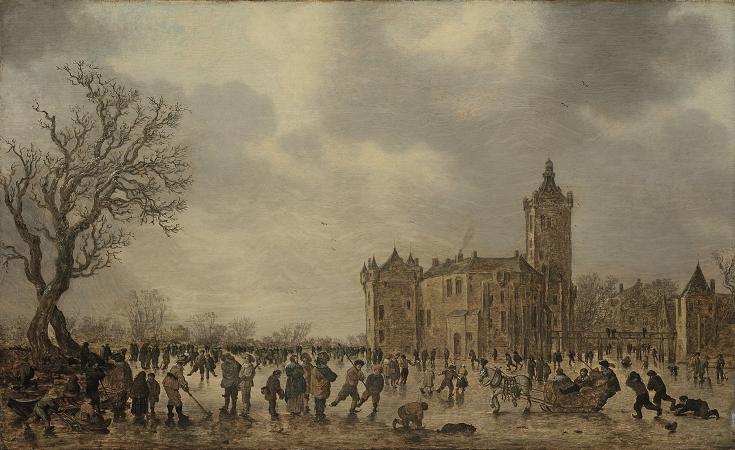Landscape with Skaters. Ice skating is the self-propulsion of a person across a sheet of ice, using metal-bladed ice skates to glide on the ice surface. This activity can be carried out for various reasons, including recreation, sport, exercise, and travel. Ice skating may be performed on specially prepared ice surfaces, both indoors and outdoors, as well as on naturally occurring bodies of frozen water, such as ponds, lakes and rivers. Research suggests that the earliest ice skating happened in southern Finland more than 4,000 years ago. This was done to save energy during winter journeys. True skating emerged when a steel blade with sharpened edges was used. Skates now cut into the ice instead of gliding on top of it. Adding edges to ice skates was invented by the Dutch in the 13th or 14th century. These ice skates were made of steel, with sharpened edges on the bottom to aid movement. The fundamental construction of modern ice skates has stayed largely the same since then, although differing greatly in the details, particularly in the method of binding and the shape and construction of the steel blades. In the Netherlands, ice skating was considered proper for all classes of people, as shown in many pictures by the Old Masters. Ice skating was also practiced in China during the Song dynasty, and became popular among the ruling family of the Qing dynasty. Ice skating was brought to Britain from the Netherlands, where James II was briefly exiled in the 17th century. When he returned to England, this 'new' sport was introduced to the British aristocracy, and was soon enjoyed by people from all walks of life. The first organised skating club was the Edinburgh Skating Club, formed in the 1740s. An early contemporary reference to the club appeared in the second edition of the Encyclopędia Britannica: The metropolis of Scotland has produced more instances of elegant skaters than perhaps any country whatever: and the institution of a skating club about 40 years ago has contributed not a little to the improvement of this elegant amusement. From this description and others, it is apparent that the form of skating practiced by club members was indeed an early form of figure skating rather than speed skating. For admission to the club, candidates had to pass a skating test where they performed a complete circle on either foot, and then jumped over first one hat, then two and three, placed over each other on the ice. On the Continent, participation in ice skating was limited to members of the upper classes. Emperor Rudolf II of the Holy Roman Empire enjoyed ice skating so much, he had a large ice carnival constructed in his court in order to popularise the sport. King Louis XVI of France brought ice skating to Paris during his reign. Madame de Pompadour, Napoleon I, Napoleon III and the House of Stuart were, among others, royal and upper class fans of ice skating. The next skating club to be established was in London and was not founded until 1830. By the mid-19th century, ice skating was a popular pastime among the British upper and middle classes, Queen Victoria became acquainted with her future husband, Prince Albert, through a series of ice skating trips, and early attempts at the construction of artificial ice rinks were made during the rink mania of 1841-44. As the technology for the maintenance of natural ice did not exist, these early rinks used a substitute consisting of a mixture of hog's lard and various salts. An item in the 8 May 1844 issue of Littell's 'Living Age' headed the Glaciarium reported that This establishment, which has been removed to Grafton street East' Tottenham Court Road, was opened on Monday afternoon. The area of artificial ice is extremely convenient for such as may be desirous of engaging in the graceful and manly pastime of skating. Skating became popular as a recreation, a means of transport and spectator sport in The Fens in England for people from all walks of life. Racing was the preserve of workers, most of them agricultural labourers. It is not known when the first skating matches were held, but by the early nineteenth century racing was well established and the results of matches were reported in the press. Skating as a sport developed on the lakes of Scotland and the canals of the Netherlands. In the 13th and 14th centuries wood was substituted for bone in skate blades, and in 1572 the first iron skates were manufactured. When the waters froze, skating matches were held in towns and villages all over the Fens. In these local matches men would compete for prizes of money, clothing or food. The winners of local matches were invited to take part in the grand or championship matches, in which skaters from across the Fens would compete for cash prizes in front of crowds of thousands.
more...














